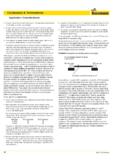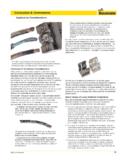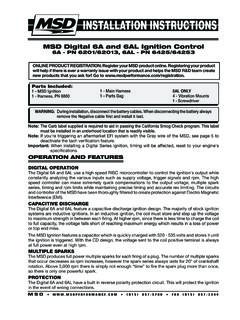Transcription of Wiring LEDs for Model Railroads 2 - TrainWeb.org
1 Using and Wiring Light Emitting Diodes ( leds ) for Model Railroads leds have many useful applications in Model railroading, including: Locomotive headlights Rear-end warning lights for cabooses and passenger cars Structure and sign illumination railroad signals Panel indicators The advantages of leds over incandescent lights include: Cost: leds typically cost 20-30% of the cost of a comparable incandescent light bulb. Heat: leds give off virtually no heat making them safe to use in plastic enclosures Life expectancy: leds , properly used, have life expectancies in the tens of thousands of hours. They will far outlast an incandescent bulb and usually the life of the modeler. Current: leds typically draw 10-30 milliamperes ( amperes), far less than an incandescent bulb. For large applications this requires a significantly smaller power supply. Color: Red, yellow, green and blue leds are monochrome and remain constant in color regardless of their brilliance. Incandescent bulbs glow predominantly at red wavelengths, but their color becomes whiter as their brilliance is increases.
2 However increased brightness also increases their heat output and reduces their life expectancy. Figure 1 LED Types Figure 1 shows a variety of leds that are available. The top row shows 5 millimeter sizes and the bottom row shows 3 mm and several mm sizes. From left to right the colors are Red Yellow Green White The color is a very bluish-white typical of fluorescent or mercury-vapor lighting. Note that Richardson Controls now sells white leds in a variety of color warmths. (Consult their web site.). Golden white Although they appear yellow, they are white encased in an amber case. The resulting light is closer to an incandescent color. They are sold for use as locomotive headlights, but can be used for interior structure lighting.. Note that Richardson Controls now sells white leds in a variety of color warmths.. Consult their web page. Bi-color (red-green) Useful for Type SA signals or panel indicators. When red and green are illuminated simultaneously, a yellow color becomes apparent.
3 Other colors (not shown), such as orange, blue, aqua and magenta are available at a higher cost. Many of these colors are offered in ultra-bright also at a higher cost. These may be used for special lighting effects. The color of an LED is determined by the internal electronics and not the case / package color. Note that the bi-color leds have a water-clear case, but display colors. The one complication of using leds is that they are polarized, meaning that in DC. circuits correct polarity must be observed. However they may be used directly in AC. circuits (such as DCC track power or 60 Hertz AC) with an appropriate dropping resistor. They will illuminate only when the AC current is flowing in the correct direction, but the on-off frequency (flicker) is so high that the flicker is not visible to the human eye. leds come in a variety of sizes, but for Model work the two most convenient sizes are 3. and 5 millimeter diameters, (see Figure 1.) The example below shows Wiring for a three- color Type D signal using 3 mm leds for insertion into an Oregon Rail Supply type D.
4 Target. It is quite useful to make a jig to hold the leds while soldering leads to them, as shown in Figure 4. The LED should fit snugly in the jig, but if it is too loose a small piece of paper towel will tighten it. The first step after inserting the leds into the jig is to test their polarity to ensure that they are correctly oriented. Use a simple homemade test device, as in Figure 2, that uses two AA batteries. Most leds will work safely on three volts, but some will burn out at that voltage. If the ones you are using require a lower voltage, add a dropping resistor to one of the test leads. Try a 100 ohm resistor, then work up or down, if necessary, to find a safe value. Figure 2: LED Tester; The battery holder and test leads are available at Radio Shack Another method for testing leds is to purchase an LED tester from All Electronics, shown in figure 3. In addition to testing whether the LED is functional and to determine its polarity, it provides an indication of its approximate current rating.
5 You can use this rating to calculate an appropriate bias resistor value using Ohm's Law: Resistance (Ohms) = Voltage (Volts) / Current (Amperes). Example: 250 Ohms = 5 Volts / Amperes Figure 3 All Electronics' LED Tester Example: 250 Ohms = 5 Volts / Amperes (20 milliamperes). Resistors do not come in every conceivable value, so that if the computed value does not match a commercially available one, select the closest available value. The closest to 250. Ohms is either 240 or 270. When in doubt, select the higher value. Remember that close only counts in horses, hand-grenades and resistors. Most leds use standard polarity conventions: For monochrome leds , the short lead is the cathode (negative) side (refer to Figure 1). If the LED has a flange around the bottom, it is usually flattened next to the cathode For three lead Bi-color leds (red-green), the cathode (negative) lead is the center lead, the green anode (positive) lead is usually the shortest lead on one side and the red anode is the mid-length lead on the opposite side.
6 However it always pays to test. Figure 4: Connecting the cathodes. After testing for correct polarity, loop a #30 gauge (the preferred size) wire around each cathode, pulling the loop tight around each lead, Figure 4. Radio Shack sells this as wire- wrap wire. Note that there is a pigtail extending from the red LED to serve as a common ground that you may solder to the mast. However the black wire may alternatively be used as the common ground. In this case the insulation should be as close to the red (Bottom) LED as possible Figure 5: Soldering the leads Using a hot soldering iron with a small chisel or point tip, quickly touch the iron and solder (designated for electrical work) to the connection, keeping the wire as close to the body of the LED as possible, Figure 5. The connection should be made in less than a second. Applying the solder directly enables the flux contained within the solder wire to wet the joint to make a good connection. For such a short duration the heat will not damage the LED.
7 Do not use general-purpose acid-core solder for electrical work. The acid flux will remain active after cooling and will eventually eat through your wire. Figure 6: Clipping the LED Leads When all the cathodes have been soldered it is a good idea to test each LED again to ensure that it has a good electrical connection and that you have correctly identified the cathode. Repeat the solder step if any leds fail to light. When all connections test positively, clip the cathode leads as close to the LED as possible, Figure 6, without cutting the common wire. Close clipping will reduce the amount that the connection extends behind the signal target. Figure 7: Connecting the Anodes For a signal application we want long lead wires that will pass down through the signal mast and reach all the way to your signal controller or power supply. Use #30 wire-wrap wire, color-coded if possible. Make a small loop in a stripped end of the wire, insert it over the anode lead and pull the loop tight, Figure 7.
8 Solder the connection as in Figure 4. For a double target signal you can pass six #30 insulated wires through a 3/32 brass tube. In this case use the mast assembly as the return ground to avoid trying to feed another wire through the mast. You can also use magnet wire that is thinner than wire- wrap wire for the same gauge, but it is coated with a non-conducting layer that is difficult to scrape off. It does not come color-coded, but you could use a marker to color it. Figure 8: Completed Assembly When all leads have been soldered to the anodes, test all leds again for good solder connections and resolder any that fail. If the test is good, clip the anodes as in Figure 6. and the pigtails that extend from the leds to eliminate the possibility of short circuits. The finished assembly should appear as Figure 8. Remove the leds from the jig and they are ready to install in a signal target. The procedure is roughly the same for Wiring bi-color leds for Type SA signals. Remember that the center lead is the cathode, and color code the red and green wires for ease in installing the signal later.
9 The leads of bi-color leds are a little closer together, so take care that you do not create a short between the cathode and either anode. If you accidently create a solder bridge between the two, you can usually cut it with a razor saw. If you are using the leds for any application other than signals, it is not necessary to cut the leads as close to the body as above. However you want to prevent short circuits by insulating at least one lead using heat shrink tubing or liquid tape.



